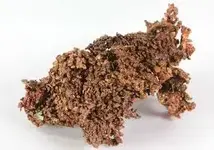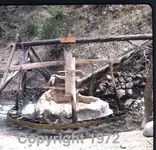Yeah. I was wondering about that what goes north question myself. What do you think about this.
https://en.wikipedia.org/wiki/Tumbaga
This might be why the Mexican civilizations needed almost pure copper from Lake Superior. If they were melting copper with gold, it would probably be to their advantage to have the purest metals they could find. But what were they trading in return. You mentioned a relay system, probably from one important village to another, along a trade route from Lake Superior to Mexico. The copper could have moved south to Cahokia, which was an important religious center. It was also a place where copper ornaments were made. Maybe raw copper moved even closer to Mexico from Cahokia, from village to village, like that relay system you mentioned. The Mexicans probably didn't even have to travel that far from Mexico, if at all. So what did they send back north? Maybe nothing. Except for the occasional gulf coast shell, there don't seem to be many items from Mexico, in the upper Mississippi River region. Maybe the copper would have been some type of tribute sent to the Mexican civilizations or some type of cooperation between people that share similar religious beliefs. The tumbaga was used to make religious objects. Just tossing some thoughts out there hoping for some archeological evidence.
Something else that I have wondered about, is why did the Copper Culture stop making tools. They stopped making tools about 3000 years ago and concentrated on ornamental objects. Doesn't make sense.
One theory is social stratification being an beginning towards the end of copper culture. Or better put (?) ...The dawn of late archaic into woodland period/people.
From the North (if a midwestern resident) came furs and meats at times for barter. South had maize beans and squash. Plus foraged stuff. Maple sugar and so forth.
Does not seem they would be interested in hauling corn from pre-Mexico when they could grow or trade locally for it.
Climate during glacial periods could factor if it was that long ago ,but copper mining/acquiring was estimated to be 500 years after last glacial retreat. Drought ,famine ,volcanic activity have all caused concerns through history..Then hauling would be worth it. (History here notes 1816 as the year without a summer due to climate disruption from a volcano. We don't have much record of earlier events ,though glacial core samples show fluctuations and climate changes over time.)
Tenochtitlan was a hub of sorts. A network extended from it , of trade.
[A thriving culture developed, and the Mexica civilization came to dominate other tribes around Mexico. The small natural island was perpetually enlarged as Tenochtitlan grew to become the largest and most powerful city in Mesoamerica. Commercial routes were developed that brought goods from places as far as the Gulf of Mexico, the Pacific Ocean and perhaps even the Inca Empire.]
If recalled correctly , ( now there's a gamble) those who began to make the site of Tenochtitlan a place to live were on the in betweens or low on the totem pole as far as status /power/ dominance in the region. They became a force though. Especially in trade.
Not knowing pre Mexico history of trade goods , I can only guess from not noting much mention of relics from there turning up in the midwest.
With exceptions only briefly read and not peer reviewed that I recall.
The lack of information regarding goods going North , combined with no evidence of habitation in the copper range teases me with the idea that those who worked the mines ,(or better yet those who distributed copper) came with tools and food to support their labor/enterprise , and left with copper.
Or...to run with your mention of smelting/working metal in the South ...Trading raw copper for a more shiny, more durable ,less polishing or turning your skin green ornaments could have been worthwhile. But evidence should exist in mounds or other sites if that happened. The more portable a good on long journys , the more it appeals.
I've lost track of the early explorer that noted decorative (?) copper axes in the pre-Mexico region , but that does not mean it was Michigan copper they were made from. It can be identified if tested by the right process. (Would be interesting if such a relic was sorted out...)
As can other precious metals pre smelting stage. Gold ores are an example , with some recognizable even to specific mines.
Arizona mines copper "dust". Add water and let it settle out. At least one mine there uses/used copper from Michigan to show copper samples. (Better than dust!)






